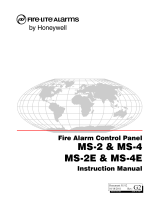Page is loading ...

© 2017 United Technologies Corporation 1 / 3 P/N P-047550-1803-EN • REV 007 • ISS 21SEP17
GSA-CR Control Relay Module Installation Sheet
Description
The GSA-CR Control Relay Module is an addressable device
that provides one Form C dry contact output relay. The relay
contacts transfer when the module is activated.
The module requires one address on the signaling line circuit
(SLC). Addresses are assigned electronically. There are no
address switches.
Diagnostic LEDs provide visible indication of the state of the
module through the cover plate:
• Normal: Green LED flashes
• Alarm/active: Red LED flashes
Personality code
The module requires the loop controller to download the
personality code that determines how the module operates.
Personality codes determine the operation of the circuit. Use
the personality codes described below to configure the
GSA-CR.
Personality code 8: Signal - dry contact output. Configures
the module as a dry relay contact to control external
appliances (door closers, fans, dampers) or equipment
shutdown.
Installation
WARNING: Connecting a device that exceeds this module’s
pilot duty contact ratings may cause activation failure. This
module does not support capacitive loads. See “Specifications”
on page 3 for contact ratings.
Notes
• The module is shipped from the factory as an assembled
unit; it contains no user-serviceable parts and should not
be disassembled.
• This module does not operate without electrical power. As
fires frequently cause power interruption, discuss further
safeguards with the local fire protection specialist.
• Install the module within the same room as the device it is
controlling.
Install in accordance with all applicable local codes and
standards and the local authority having jurisdiction.
To install the module:
1. Wire in accordance with “Wiring” on page 2.
2. Write the address assigned to the module on the label
provided, and then apply the label to the module. Remove
the serial number label from the detector, and then attach
it to the project documentation.
3. Using the screw provided, mount the wall plate on the
module. See Figure 1 for mounting details.
4. Using the screws provided, mount the wall plate (with the
module attached) on one of the compatible electrical
boxes listed in “Specifications” on page 3

2 / 3 P/N P-047550-1803-EN • REV 007 • ISS 21SEP17
Figure 1: Mounting the CR module
(1) Compatible electrical box
(2) Module
(3) Wall plate, white (single-gang)
(4) #6-32 × 5/8 machine screw
(5) #4 × 1/2 self-tapping screw
Wiring
Wire in accordance with applicable requirements of the latest
editions of the local codes and standards and the local
authority having jurisdiction.
Note: When stripping wire ends, exposing more wire may
cause a ground fault or circuit malfunction on unsupervised
wiring; exposing less wire may result in a faulty connection.
Strip 1/4 in. (about 6 mm) from the ends of all wires that
connect to the terminal block of the module.
Notes
• Refer to the Signature loop controller installation sheet for
SLC wiring specifications.
• Each terminal on the module is limited to a single
conductor.
To wire the module:
1. Verify that all field wiring is free of opens, shorts, and
ground faults.
2. Make all wiring connections as shown in Figure 2.
Figure 2: Wiring diagram
(1) Normally open contact (NO)
(2) Common contact (C)
(3) Normally closed contact (NC)
(4) Not supervised. Power-limited unless connected to a nonpower-
limited source. If the source is nonpower-limited, eliminate the
power-limited mark and maintain a minimum of 0.25 in. (6.4 mm)
space from power-limited wiring. For other mounting methods,
see enclosure and bracket installation sheets to maintain
separation of power-limited and nonpower-limited wiring. The wire
size must be capable of handling fault current from nonpower-
limited source.
— or —
Use type FPL, FPLR, FPLP, or permitted substitute cables,
provided these power-limited cable conductors extending beyond
the jacket are separated by a minimum of 0.25 in. (6.4 mm) space
or by a nonconductive sleeve or nonconductive barrier from all
other conductors. Refer to the NFPA 70 National Electric Code for
more details.
(5) Signaling line circuit (SLC) to next device
(6) Signaling line circuit (SLC) from previous device
(7) Power-limited and supervised
(1)
(2) (3)
(4)
(4)
(5)
(1) (3)(2)
+ +
(4)
(5)(6)
(7)

P/N P-047550-1803-EN • REV 007 • ISS 21SEP17 3 / 3
Specifications
Operating voltage
15.20 to 19.95 VDC
Current
Standby
Activated
85 µA
85 µA
Ground fault impedance
10 kΩ
Contact ratings (pilot duty)
24 VDC at 2 A
120 VAC at 0.5 A
Relay type
Form C, programmable, Class E
Circuit designation
Signaling line circuits
Class A, Style 6 or Class B, Style 4
Wire size
12 to 18 AWG (0.75 to 2.5 mm²)
Compatible electrical boxes
2-1/2 in. (64 mm) deep single-gang
box;
Standard 4 in. square,1-1/2 in.
(38 mm) deep box
Operating environment
Temperature
Relative humidity
32 to 120°F (0 to 49°C)
0 to 93%, noncondensing
Storage temperature range
−4 to 140°F (−20 to 60°C)
Regulatory information
North American
standards
CAN/ULC-S527, UL 864
FCC compliance
This device complies with part 15 of the FCC
Rules. Operation is subject to the following two
conditions: (1) This device may not cause
harmful interference, and (2) this device must
accept any interference received, including
interference that may cause undesired operation.
Contact information
For contact information, see www.kiddelifesafety.com.
/

